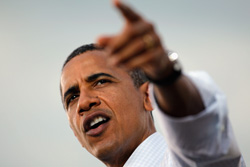 Coming out of Labor Day weekend, you could properly conclude that nothing is working in Washington, or in the rest of America.
Coming out of Labor Day weekend, you could properly conclude that nothing is working in Washington, or in the rest of America.
Hidden one layer below the ghastly goose egg for net jobs created in August was even more dismal news: Health care added 30,000 jobs while manufacturing lost 3,000. This is precisely the wrong distribution of new employment that we should want. In addition, the workforce participation rate has drifted down to 64 percent, compared to more than 66 percent three years ago, and the number of people not counted as being in the workforce has increased by 3 million over the past year. These are dangerous long-term trends. Fewer people in the measured workforce masks what would otherwise be an even higher unemployment rate and means less income earned and less wealth created.
One small cause of the employment stagnation: Solyndra, a leading solar panel manufacturer that had received more than $500 million in federal loan guarantees, filed for bankruptcy, as did two other leading American solar companies. The solar sector was supposed to be one of the green shoots in the economy, and federal stimulus dollars allocated to the sector were supposed to boost us into a global leadership position. Not so. The Chinese government, through grants of free land, zero interest loans, and the ubiquitous cheap labor available to Chinese manufacturers, is still besting us.
This bodes ill, and raises a much more fundamental issue about global economics. The accepted wisdom that trade lifts all ships through the wonders of comparative advantage is proving to be false. Through currency manipulation, piracy of intellectual property, state loans, and free land, statist capitalism in China and other competing nations has an unfair advantage. It can exploit the comparatively free access to our markets. Michael Spence brilliantly analyzed this in his Foreign Affairs article, "Globalization and Unemployment," showing that over the past 20 years we have had virtually zero job growth in the tradable sector. Our job growth has come primarily in health care and government. That is not a business model that works long term. Free trade is simply not working for most of the U.S. economy.
But that's not all the dismal news. For reasons I can't quite fathom, the White House pulled back from science-based rules related to smog emissions, and retreated to the Bush administration's watered-down version. Once again, the White House was gutless about science, and if they think retreating over smog will win back business leaders, they are dead wrong. The Chamber of Commerce just views them as weak. And if the White House thinks this won't further demoralize the president's supporters on the left, they are wrong about that, as well.
Which brings us to the president's latest opportunity to reset the debate: his jobs speech on Thursday night. He will need to demonstrate a boldness we haven't seen from him in some time. The speech must be a new State of the Union, an articulation of what we need to do to get the engines working again. The Republicans won't pass anything he proposes anyway, so he shouldn't water anything down. He should challenge Congress and the public with bold and transformational ideas. A few suggestions for what he could propose:
1. Redefine the entire tax code?eliminate all the loopholes, lower marginal rates, and eliminate all differentiation between capital gains and ordinary income.
2. Propose a carbon tax and an increase in the gas tax to begin to move us to a rational energy system. (These tax proposals could make the system more, not less, progressive, if done properly.)
3. Raise the age of eligibility for Social Security and Medicare. Do it gradually, but do it.
4. Create a mechanism to refinance mortgages for those who are current on their payments but paying above-market rates. The feds can help them refinance through the federal government's capacity to borrow at historically low rates. (There are many sound proposals to do this, from conservative, centrist, and liberal economists.)
5. Create a jobs program that will employ millions of the unemployed. One creative idea would be requiring that those receiving federal contract hire additional workers.
6. Slap a tariff on the Chinese equal to our best estimate of the amount by which they are manipulating their currency. Let them complain. They will still buy our bonds: They have nowhere else to put all their cash.
Most importantly, the president needs to get tough. It doesn't matter that the Republican presidential candidates are proposing crazy ideas: He is still losing. If he wants to recover, he needs to take a stand, fight back, and get creative.
Like Slate on Facebook. Follow us on Twitter.
Eliot Spitzer is the former governor of the state of New York.Photo by Joe Raedle/Getty Images.
Source: http://feeds.slate.com/click.phdo?i=4fa48eab1f83987b0b03df3743c1277b
wilfred constantine kourtney kardashian kourtney kardashian andy murray area 51 valencia
No comments:
Post a Comment
Note: Only a member of this blog may post a comment.